Introduction and a bit of History
I know that to many of you, the DC-3 is bound to seem like an
old friend! I was first introduced to her in real life at
Gatwick Airport in 1959, when I was on my way to a holiday in
the Costa Brava, but it wasn't until years later, when I was
given FSX, that I renewed our relationship. This was at the
start of the Congo Relief Mission in FSX and we've been having
flight-sim adventures ever since. Quite coincidentally, I am
writing this Review exactly 75 years to the very day of the
DC-3's first flight - 17th December 1935, at Clover Field in
Santa Monica, California. And, you'll probably know that on the
same day, 32 years previously, the Wright Brothers had made
aviation history with the first ever flight at Kitty Hawk, North
Carolina. An auspicious day indeed - and Just Flight have done
well to release this add-on from Aeroplane Heaven just before
this historic joint 'birthday'. Before getting down to the
review proper, here's a reminder of the Dizzie's legendary
history.
The DC-3, or C-47 in its military guise, represents the
archetype 2-engine prop aircraft. In all, more than 16000 were
built, with over 10000 C47s produced in the U.S. during WWII, of
which around 2000 C47‟s became RAF "Dakotas". Nearly 5000 were
built under licence in Russia and a further 487 in Japan, where
production continued even after the attack on Pearl Harbor!
Many of the C-47 used by the Allied Air Forces were subsequently
refurbished for post-war commercial use, becoming the back-bone
of many airlines short haul routes.
Download and Installation
The JF DC-3 comes in 2 volumes - the Base Pack, which is just
under 300 Mb, and an Expansion Pack of almost 200 Mb.
Downloading these files from the Just Flight website was very
straightforward. These 2 files, together with the Enhanced Sound
Pack, 55 Mb, took less than 5 minutes to transfer. The
installation of each Pack followed successfully, so I opened up
the FSX folders to see what was new.
Within the main Microsoft
Flight Simulator X folder, I found that the Just Flight folder
(created from a previous JF product installation) contained a
new folder - 'DC3'. This contained the Manual, in PDF format,
together with the Paint-Kit folder and an application (.exe)
file called 'Open' - which is used to change the glider tow tug
from the default Maule to the C-47.
Looking further into ...\SimObjects\Airplanes, I found 9 new
'model' files, which housed the variants of the DC-3 and C-47
included in the add-on, together with the Waco CG-4 Glider.
Everything was looking fine - the problem now was to work out
where to start! Let's take a closer look at the various models
that have appeared in the hangar...
DC-3/C47 Models and Aircraft Variants
The following variants of the DC-3/C-47 are installed - first
the pre-WWII Commercial Airline DC-3s, powered by the 1000 hp
Wright Cyclone R-1820 9 cylinder single-row supercharged
air-cooled radial engine:
 |
After WWII, a large proportion of the surviving 'Skytrain' C-47s were converted to commercial use. Powered by the 1200 hp Pratt & Whitney R-1830 14 cylinder double-row air-cooled radial engines, you'll find the following installed:
 |
The Military C-47 variants from WWll, used the Pratt & Whitney R-1830 engine and include:
 |
Lastly, you will find a flyable model of the Waco CG-4 'Normandy' troop carrying glider, as used by U.S. troops in the invasion of Sicily and the D-Day assault on France on June 6, 1944.
First Impressions
Now, with these impressive range of options, where was I to start? Like I said earlier, I'd met my first "Dakota" at Gatwick Airport in 1959, and as that was my first ever experience of flying, I thought 'Why not? Perpignan, here we come!' Transair, who were a division of the Airwork Services, operated Dakotas out of Gatwick for a number of package tour holiday companies and, as Airwork were to amalgamate with Hunting-Clan Air Transport in 1960 to form British United Airways, I chose that model for my first flight.
Gatwick was heralded as the most up-to-date airport in the world, at that time, because it was the only one that had both a rail and major road linked to the main terminal. No jetways that I can remember, so we had to walk to the aircraft from the departure lounge.
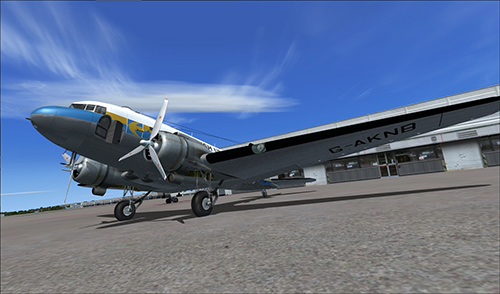 |
In the cockpit, the 2 pilots and navigator/engineer, were completing pre-flight checks, as we taxied to the end of runway 08 - the only one, in those days.
Back in the main cabin, we were issued with our boiled sweets. Huh? No pressurised luxury on this Goonie Bird! The air-hostesses told us that sucking the sweeties would reduce any ear–ache problems as we climbed to our cruising height of – wait for it – 9500 feet... Here we are starting to cross the Channel by Seaford, East Sussex.
 |
 |
The flight plan was fairly simple: climb out and head south towards Chartres, continue on towards the MENDE VOR, in the Lozère Department of southern France. Here, we would start the descent, flying over the Mediterranean, before turning back north towards Perpignan. From the actual flight, back in 1959, I can remember the Captain coming around the cabin and letting us passengers see his map, on which the route had been drawn in red biro! When he reached me, he pointed out the window, towards the high ground beneath us. “That's the Massif Central – where the Limousin cattle come from - we'll reach the Med in a few minutes!”.
 |
He disappeared forward and made the announcement that we would soon be descending. The stewardess dished out more boiled-sweets and the Seat-Belts and No-Smoking (!!) signs turned on with a bong. Back in the cockpit, the Captain brought us smoothly onto the approach to Rivesaltes Airport and we were touching down within minutes..
On the apron by the terminal building, the services B.U.A. truck brought out the steps and we were soon disembarking under the watchful eye of the stewardess.
 |
 |
Just over 4 hours from Gatwick – we were led to our waiting coach, which would take us on, across the border, to Lloret. My first DC-3 flight was complete, so it is time to get to grips in more detail with Just Flight's DC-3.
External Model
Now, you've seen some introductory screen-shots, so you will already have an idea of the level of detail that the Aeroplane Heaven designers have employed on the exterior of the models. Believe me, the detailed rendition of the aircraft is really excellent. Each airline's livery has been reproduced exactly, and the military variants are equally convincing. Landing gear, aileron and flap mechanisms, are modelled in fine detail as are those internal details that can be seen through open doorways and windscreens, etc.
 |
In particular, I was taken with the detailed modelling of the radial engines – quite brilliant! Each commercial aircraft is supplemented by a series of additional model features including entry stairways and service minibuses carefully rendered in the appropriate airline livery.
Likewise, the military variants offer cargo crates, loading ramps, complete with vehicles and servicemen.
 |
 |
All in all, very impressive - so, let's have a look inside.
Virtual Cockpit and Interior Model
From a visual point of view, you will not be disappointed with the VC - the perspective sweep of instruments gives an excellent, if rather 'factory fresh' impression. Each dial is presented immaculately, which enhances the 3-D 'feel' of the cockpit.
The flight controls, between the pilot and co-pilot, look quite realistic and respond well to the mouse, as do nearly all the switches in the upper panel.
 |
 |
Almost all the instruments come with a 'mouse-over' tool-tip, which is a distinct advantage when the instruments themselves are quite compact. With a little practice, I was eventually able to adjust the heading and elevator trim on the Sperry Gyro-Pilot - once you know how and where to drag the mouse, it is possible to make these changes. Basic VFR flying with the VC is relatively straightforward, but I've some more to say about instrument flying later.
Leaving the VC, you can explore the remainder of the interior model. Now, there is a major difference, here, between the commercial and military models. With the commercial aircraft models, you must select the Left Seat cabin view from the drop down menu. Each commercial variant comes with an interior decorated in the livery style of the airline - head-rests, seat colours, etc, as is the uniform of the stewardess - and very smart she is, too.
 |
With the military variants, however, you can simply turn around, and move to the rear of the aircraft, first, to the Radio Operator/Navigator station. This has the actual radios that can be controlled by the over-head VC radio-panel and are quite similar. Beneath the radio is the Navigator's table - there's even a map for the paratroop carrier operation.
Looking up, you will see the Perspex dome in the roof, through which the Navigator could take sextant bearings. (You may have noticed that this bubble is missing on the default DC-3!) Continuing aft, we come into the main cabin.
 |
 |
The interior model reflects the use of the variant, so, you'll find a jeep in the U.S. Payload C-47, mounted machine guns in the Puff and Spooky 'Fighter Cargo' variants, and so on.
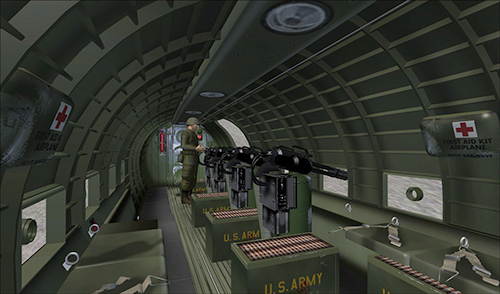 |
Flight Dynamics
The modified air file contains changes to the MainWing parameter but little or no other changes from the original air file. In flight, the Just Flight DC-3 feels very similar to the default (M.S.) aircraft so no worries as the Dizzie is one of the most forgiving aircraft in both FS9 and FSX.
Animations and Special Features
The animation of the main moving parts of the aircraft has been extremely well executed. The under-carriage and flap mechanisms are exactly like the real thing and the same applies to rudder, ailerons and elevators. The small crew door - yes, for 'small crew'! - opens with Shift 'E' and the main cabin and cargo doors open with the addition of the '2' and '3' keys. In the VC, practically every switch and lever is operational, i.e. you can turn on the wind-screen wipers when you run into snow.
 |
Some of the special features of the external model have been described already and these certainly add to the enjoyment of using the models, particularly in developing more complex screen shots to accompany your narratives! When I saw the 'split screen' VW micro-bus, I was immediately transported back to those heady days of the sixties when we all searched for the perfect wave - now that's radical, Dude!
The military C-47's were initially used as troop/cargo/vehicle carriers during WWII and the jeep, seen internally, can be switched to the loading position, using the VC.
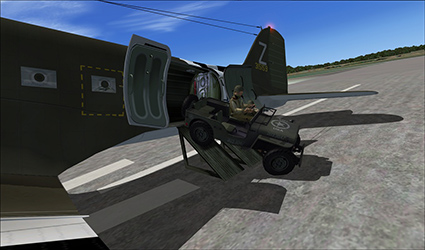 |
 |
The 'Spooky' and 'Puff' gun-ship variants (sometimes designated FC-47) were used extensively for suppressing fire and ground troop support in Vietnam. The three or more General Electric 7.62 mm mini guns could be actuated by the pilot from his yoke.
In terms of special features, however, the icing on the cake has to be the Waco CG-4A troop glider. Not as big as the RAF's Horsa, which required a 4-engined tug, the Waco was ideal for the C-47 to tow into operations. The Aeroplane Heaven team have provided 2 options:
 |
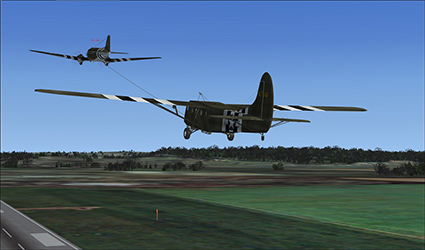 |
 |
 |
PDF Manual
I'm gradually getting used to PDF Manuals - I confess that I still prefer an old style printed version (which, I understand is available with the boxed product?), but I've got to say that the Just Flight DC-3 PDF Manual is well presented and most comprehensive. There's a good introduction to the DC-3 and C-47 history followed by a more detailed description of the different variants. The section on the operation of the VC panel is aided by the inclusion of several annotated panel screen shots, with brief descriptions for each instrument, switch and lever, etc.
The Manual continues with a section on flying the DC-3/C-47, dealing in detail with start up, taxiing and take-off, cruise, approach and landing. Clear instructions for each phase are given using the VC. Following this is an extremely interesting section on the Waco Glider - how it can be towed with the C-47 Tug and also flown as an aircraft in its own right. Just Flight clearly want you to enjoy using the Waco CG-4 Glider as they have put a great deal of effort into this section, which is almost 20% of the Manual!
Pluses and Minuses
Nearly everything I've dealt with so far has been positive and I've got to say that I like this add-on immensely. From the view point of looks alone, this Just Flight product really takes the biscuit. However - I've got to come clean on my major misgivings - in any flight other than VFR, over country that you already know, you might find some problems. Again, it could be unfamiliarity with the aircraft that leads me to these conclusions, so bear that in mind too!
The first big negative is the default 2-D Panel. We've all used it and know there are several instruments missing - particularly a decent VOR Indicator for navigation and ILS. O.K., you can 'borrow' a 2-D Panel from another aircraft to remedy this, but it's a great shame that, after taking so much care with the model, that the Aeroplane Heaven development team didn't come up with any alternative to the M.S. default panel.
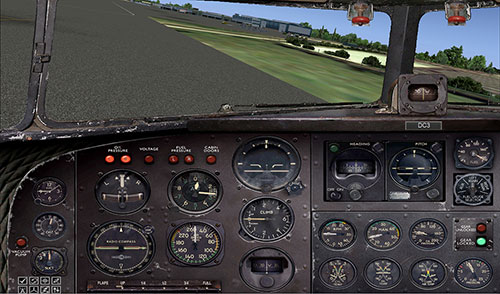 |
Unfortunately, for me at least, the VC Panel doesn't compensate for the poor 2-D Panel. Now, I know there's a trend these days to concentrate design effort on the VC, particularly on the big jets, where the VC is possibly the main attraction to those simmers who derive so much pleasure in following exacting procedures from cold start to ultimate shut down.
The Manual does say: " For the purposes of this simulation we have chosen an "average" fit-out, incorporating most of the equipment and features found in the cockpits of the time." I found 2 major difficulties: the VOR/ILS and the Sperry Gyro-Pilot:
| Mind you, as there is a fully functioning GPS
available, these disadvantages may not affect your own
approach to navigation - it's a question of preference -
but it does make landing in poor visibility more of a
nightmare! Just Flight have some good news however, in the upcoming service pack they are including a new radio compass, which will make navigation from the VC much easier and more in keeping with the early C47s'. (See right) |
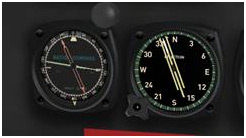 |
Again AH have redesigned the Sperry after customer feedback, the newer version shown below will be included in the service pack and will be easier to use and will function better than the existing Sperry.
Lastly, and this is just a minor niggle, I had some problems with taxying. Despite unlocking the tail wheel, the aircraft wouldn't respond readily. This was resolved, however, by inspecting the aircraft.cfg and modifying the tail-wheel contact points data, as per the instructions in the file. Well hidden, I thought - but it did work!
Service Pack
| As I have hinted above, it would be worth mentioning the service pack which will be released soon, here is a list of what to expect: • The airspeed indicator now displays in knots rather than MPH • The radio altitude gauge has been modified to more realistically reflect the real unit (within FS limitations) • A marker beacon light gauge (OMI) has been included to assist with low visibility ILS landings • AH have reshaped the tail-cone following customer feedback • All reported issues fixed (incorrect cylinder temps, trim control issues etc) |
 New ASI |
![]()
Verdict
I thoroughly enjoyed doing this Review of the
DC-3/C-47 and can wholeheartedly recommend the Just Flight
DC-3/C-47 add-on to you.
The aircraft exterior and interior modelling is excellent
and the additional features, particularly the Waco Glider,
make it a 'must have' addition to any simmer's hangar.
If it weren't for my personal misgivings about the lack of
navigational instruments, I'd have no problem in giving the
DC-3/C-47 full marks, but my final score is below.
We have seen that AH / Just Flight do listen to customer feedback
and with the upcoming service pack coming they're smoothing off some
of the rough edges and I know now that you will very much
enjoy flying the DC-3, as I have done these past few days.
Mutley's Hangar score of
9/10
![]()
David Williams
Review machine Spec: Q9400 2.67 GHz |
4Gb Ram |nVidia GeForce 8800 GT 512 Mb |Windows 7 64bit

